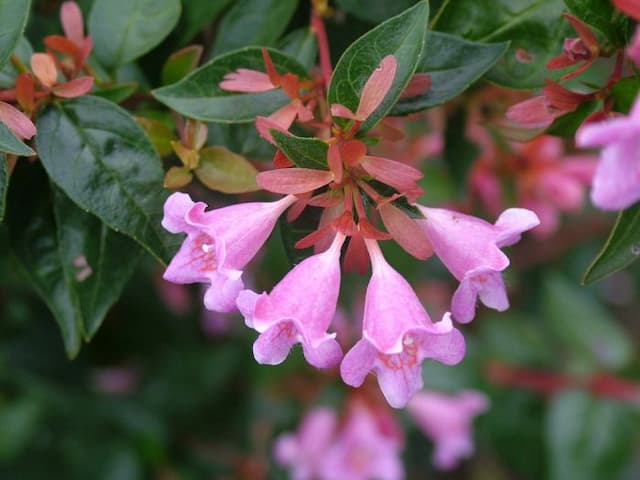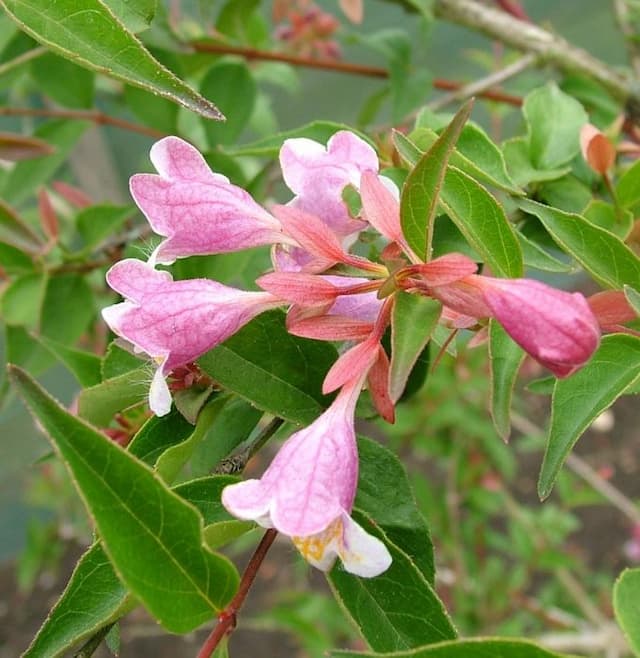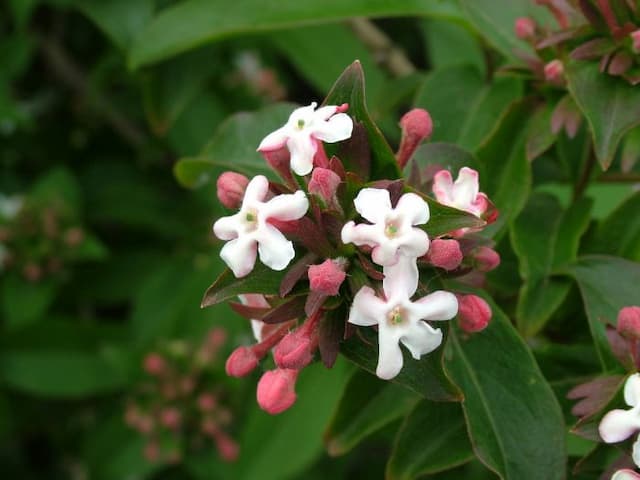Weigela Weigela coraeensis 'Eva Rathke'

ABOUT
The Weigela 'Eva Rathke' is a striking ornamental shrub known for its showy appearance. This plant features arching branches that create an appealing, mounded form. The foliage of 'Eva Rathke' is composed of oval-shaped leaves that are typically a deep green hue, providing a lush and dense backdrop for the flowers. The true spectacle of this plant is its blooms. 'Eva Rathke' is adorned with a profusion of crimson flowers that are shaped like small, funnel-like bells. These flowers are rich and deep in color, often with a slightly ruffled edge, which adds an extra touch of elegance to their appearance. These flowers stand out dramatically against the dark green foliage and tend to bloom in the late spring to early summer. Overall, the Weigela 'Eva Rathke' is cherished for its vibrant and abundant flowering. This shrub is frequently utilized in gardens for its ornamental qualities and its capacity to attract hummingbirds and other pollinators, thanks to its showy and nectar-rich flowers. Its appealing form and captivating color make it a favorite among gardeners looking to add a splash of color to their landscape.
About this plant
 Names
NamesSynonyms
Weigela, Eva Rathke Weigela.
Common names
Weigela coraeensis 'Eva Rathke'.
 Toxicity
ToxicityTo humans
Weigela is not commonly listed as a toxic plant to humans. However, as with any plant material, individuals may have varying sensitivities, and ingesting plant parts is not advisable. If accidental ingestion occurs, watch for any adverse reactions and consult a medical professional if symptoms develop. It's always best to err on the side of caution and keep plants out of reach of children who might be tempted to taste them.
To pets
Weigela is not known to be toxic to pets. It is always wise to prevent pets from consuming plants as a precaution, as individual animals can have unique reactions to plant materials. If your pet does ingest Weigela and you notice any unusual symptoms, contact your veterinarian. It is important to be observant for any signs of gastrointestinal upset or distress after ingestion of plant parts by pets.
 Characteristics
CharacteristicsLife cycle
Perennials
Foliage type
Deciduous
Color of leaves
Green
Flower color
Red
Height
6 feet (1.83 meters)
Spread
6 feet (1.83 meters)
Plant type
Shrub
Hardiness zones
5
Native area
Korea
Benefits
 General Benefits
General Benefits- Ornamental Appeal: The Weigela 'Eva Rathke' has attractive trumpet-shaped flowers with a deep reddish-pink hue that add vibrant color to gardens during late spring and early summer.
- Growth Habit: This shrub has a compact and bushy growth habit, which makes it suitable for smaller gardens or as part of mixed borders.
- Attracts Wildlife: The blooms are known to attract hummingbirds, butterflies, and other pollinators, thus supporting the local ecosystem.
- Low Maintenance: Once established, Weigela 'Eva Rathke' is relatively low maintenance, requiring minimal pruning and care.
- Drought Tolerance: This plant species exhibits good drought tolerance once established, making it suitable for xeriscaping or regions with less rainfall.
- Seasonal Interest: Provides extended seasonal interest with blooms in spring and often a second flush of flowers in late summer, along with occasional colorful foliage in autumn.
 Medical Properties
Medical PropertiesThis plant is not used for medical purposes.
 Air-purifying Qualities
Air-purifying QualitiesThis plant is not specifically known for air purifying qualities.
 Other Uses
Other Uses- Photography backdrop: The vibrant blooms of Weigela can provide a stunning natural backdrop for outdoor portrait photography.
- Educational use: Schools and educational institutions can use Weigela as a study specimen in botany and horticulture courses.
- Culinary garnish: Though not commonly eaten, the flowers can be used as ornamental garnishes for plating in high-end culinary presentations.
- Artistic inspiration: Artists may use Weigela's striking flowers as inspiration for artwork, including paintings and textile designs.
- Eco-friendly confetti: Dried petals of Weigela can serve as a biodegradable confetti alternative for celebrations.
- Nature crafts: People can use branches and flowers for making natural wreaths, decorations, or for other crafting projects.
- Wildlife habitat enhancement: The dense foliage can provide shelter for small wildlife in suburban gardens or urban green spaces.
- Theme gardens: Weigela can be included in theme gardens, such as Victorian gardens, to create an authentic historical look.
- Soil erosion control: Planting Weigela in sloped areas can help stabilize soil and prevent erosion with its root system.
- Living fence: When planted in a row, Weigela can be trimmed and maintained as a flowering hedge or living fence for privacy.
Interesting Facts
 Feng Shui
Feng ShuiWeigela is not used in Feng Shui practice.
 Zodiac Sign Compitability
Zodiac Sign CompitabilityWeigela is not used in astrology practice.
 Plant Symbolism
Plant Symbolism- Weigela (in general): Since the plant Weigela is not widely recognized for having specific symbolic meanings as some other plants do, interpretations are more general. Often, Weigela symbolizes a welcoming gesture or inclusion since its abundant spring flowers seem to invite pollinators and signify the welcome arrival of spring.
- Beauty of Nature: 'Eva Rathke,' with its striking blooms, represents the beauty of natural wonders, highlighting the aesthetic appeal and diversity of flora in gardens and landscapes.
- Resilience and Adaptability: Being a hardy shrub that easily adapts to different growing conditions, it can symbolize resilience and the ability to thrive in varying environments.
- Renewal and Hope: As a recurrent bloomer, Weigela 'Eva Rathke' symbolizes renewal and the idea of life's continual renewal, just as it rejuvenates its leaves and blooms each year, offering a sense of hope and new beginnings.
 Water
WaterThe Weigela 'Eva Rathke' enjoys consistently moist but well-drained soil. During the first growing season, ensure to water it deeply once a week, which equates to about 1 to 1.5 gallons of water for each plant, depending on the weather conditions. After establishment, the Weigela generally requires less frequent watering, depending on rainfall and temperature, but about 1 to 1.5 gallons per week during dry spells is usually sufficient. Always check the soil about an inch below the surface; if it's dry, it's time to water. During extreme heat or drought, increase watering frequency to prevent stress to the plant.
 Light
LightThe Weigela 'Eva Rathke' thrives best in full sun to partial shade. Ideally, you should place it in a spot where it can get at least 6 hours of sunlight a day. Avoid deep shade as it can lead to sparse blooms and a less vigorous plant. Morning sun with afternoon shade can also work well, especially in hotter climates.
 Temperature
TemperatureWeigela 'Eva Rathke' is able to handle a range of temperature conditions and is hardy in USDA zones 4 through 8. The ideal growing temperatures for this plant range between 60°F and 75°F, but it can survive winter dips down to -30°F and summer highs that soar well above 75°F. To maintain its health, try to avoid planting in locations where temperatures fall outside these extremes on a regular basis.
 Pruning
PruningWeigela 'Eva Rathke' should be pruned for shape and to remove any dead or crossed branches. The best time to prune is immediately after the spring flowering has ceased, as this plant blooms on old wood. A general rule is to not remove more than one-third of the plant in a given year. Annual pruning helps to encourage healthy growth and abundant flowering for the next season.
 Cleaning
CleaningAs needed
 Soil
SoilWeigela 'Eva Rathke' thrives in well-draining soil with a mix of loam, peat, and sand to retain moisture while preventing waterlogging. The best soil pH for this shrub is slightly acidic to neutral, ranging from pH 5.5 to 7.0. Amend with organic matter annually to maintain soil fertility.
 Repotting
RepottingWeigela 'Eva Rathke' typically does not require frequent repotting as it's a larger shrub primarily grown outdoors. When grown in containers, it may need repotting every 2-3 years to refresh the soil and accommodate root growth.
 Humidity & Misting
Humidity & MistingWeigela 'Eva Rathke' is adaptable to a wide range of humidity conditions and does well in the average outdoor climate. It does not require specific humidity levels to thrive but prefers not to be in excessively dry air for extended periods.
 Suitable locations
Suitable locationsIndoor
Ensure bright light, well-draining soil, moderate watering.
Outdoor
Plant in sun to part shade, ensure well-draining soil and space.
Hardiness zone
4-8 USDA
 Life cycle
Life cycleWeigela florida 'Eva Rathke' starts its life cycle as a seed, which upon germination in the right conditions—"light", warmth, and moisture—will sprout and grow into a small seedling. The seedling enters a vegetative phase where it rapidly grows leaves and stems, establishing a strong root system, and eventually maturing into an adult plant. Once mature, it displays its distinctive trumpet-shaped flowers in late spring to early summer, attracting pollinators with its vibrant blooms. After pollination, the plant sets fruit, typically in the form of small capsules, which later dry and release seeds, propagating the next generation. The plant continues to grow and will experience phases of dormancy, especially in colder climates, where it loses leaves and enters a period of rest during the winter months. With proper care, 'Eva Rathke' can live for many years, going through repeated cycles of growth, blooming, and dormancy.
 Propogation
PropogationPropogation time
Spring-Early Summer
The most popular method of propagation for Weigela florida 'Eva Rathke', commonly known as Weigela, is through semi-hardwood cuttings. This typically takes place in late spring to early summer when the plant's new growth has begun to mature but is not yet fully hardened. You would cut a 4 to 6 inch (10 to 15 cm) length of stem that includes several leaves using sharp, clean pruning shears. The bottom inch of the cutting should be stripped of leaves, and the cut end dipped into rooting hormone to encourage root growth. Then, the cutting is placed in a pot filled with a mix of peat and perlite or sand, ensuring that the leaf-free portion is buried. The pot should be kept in a warm, bright location out of direct sunlight, making sure the soil stays moist but not waterlogged. Roots usually develop within 4 to 8 weeks, after which the new Weigela can be transplanted to a more permanent location.








![Himalayan honeysuckle [Golden Lanterns]](/_next/image?url=https%3A%2F%2Fplants-admin.emdemapps.com%2Fimages%2Fplants%2F%2Fimages%2F604b55302cc87.png&w=640&q=75)
